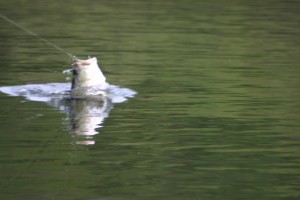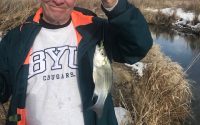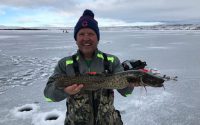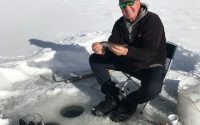Topwater Awaits On Powell
This time of year Lake Powell beckons to recreational campers, boaters, and tourists alike and the 1900 or so miles of shoreline, countless coves, and bays seem to swallow you up. Anglers live and die by the topwater bite for the next couple of months and this column is dedicated to teaching you how to maximize your opportunities to catch fish on the surface.
The first thing to always keep in mind is that there are three main species of fish that generally will hit baits and lures on the surface in Lake Powell. These species are largemouth and smallmouth bass, and stripers. Occasionally, I do catch crappies and bluegills on the surface, but most of the action will revolve around bass and stripers.
The water level is at its yearly high and will begin in the next few weeks to slowly drop once again. The good news is that there is a significant amount of flooded brush in the backs of coves and on flats that will produce some very nice fish when fished properly.
Right now, forage fish like shad are running in schools though each minnow is very small (many less than one inch in length). The stripers are chasing these schools of bait and will come to the surface as they feast on the bounty. It is important to know that bass will treat schools of shad in several different ways depending on the time of day and the location of the schools. Bass and stripers will “Slurp” small fish on the surface and at times will move along with their backs out of the water eating as many tiny minnows as they can.
Next, they will pluck individual minnows from underneath the schools. In this case, only small “dimples” will appear where the minnows are being forced to the surface, and then a small ring will appear where a predator fish has eaten a minnow from below and just barely broke the surface of the water doing so.
Finally, bass and stripers will “explode” on the surface as hundreds of fish surround, chase, eat and destroy schools of bait fish that become trapped either by being surrounded by schools of stripers and bass, or the minnows are chased into a bank or to the back of a cove where they have no place to hide. These are the times most anglers dream of because catching bass and stripers in this particular set of circumstances becomes much easier.
When fishing bass and striper “boils” it is best to be on the water just before first light. According to reports, the central and northern parts of the lake are producing better than the south areas so if you are launching at Bullfrog Marina, you should be able to see some great boils and find some great action between the mouth of Iceberg Canyon to the south, and Red Canyon to the north. The mouth of Bullfrog and Halls bays are excellent places to look as well as the buoy fields nearby. Good Hope Bay holds great numbers of bass and stripers and once again on the main channel close to the mouth of Good Hope Bay would be a great place to look for fish.
Approach schools of feeding fish slowly but with a purpose. Make long casts with your favorite topwater lures right into the middle of the boils. Zara Spooks, poppers, spinnerbaits, and shallow-running crankbaits will work very well but remember, the key is to make long casts. Practice between boils so you know how far you can throw your lures.
Always remember that just like the early morning, the last rays of evening light will produce some of your finest fish. If you can put up with the heat, the topwater action should be as hot as the weather and should last through September. Good Luck!
- Slurping bass will come out of the water for your topwater lure.











